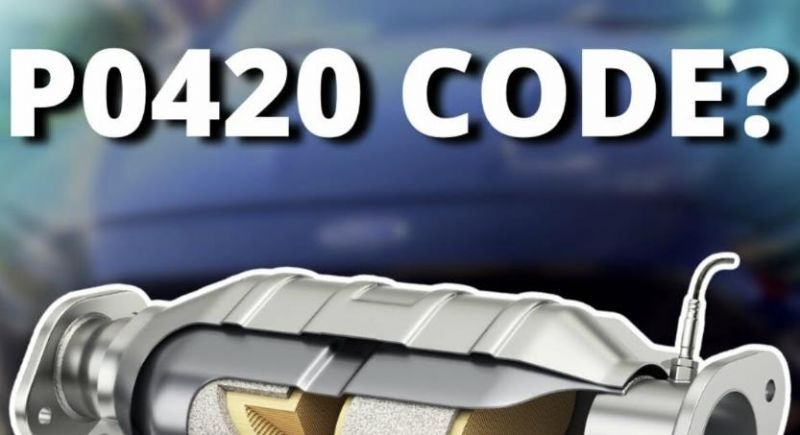Introduction to P0420 Code
If driving extends your achievement that has resulted in a P0420 Code, you probably know what i am talking about and this is very true. It may seem scary at first but then it is a piece of cake that has to be solved for the turbo to work properly. The first code, P0420, suggests: *Calm down, folks. That’s a problem; more specifically, a problem with your car’s catalytic converter. Do not worry; we will do these step-by-step.
So, are you an avid lover of cars or a very normal person who doesn’t want to leave their vehicle in the garage all the time, if you understand the P0420 codes and strategies, you are on the right course. You are about to venture deeper into this book because of the cause of this alarm and the way out of the problem!
Understanding the Catalyst and Its Function

Of all the components in every automobile, the component that stands out is the catalytic converter, which is incorporated into the exhaust system. Regarding emission control systems, this particular component is responsible for preventing pollutants from being emitted outside the vehicle. This device aims to reduce environmental risk because harmful gases and substances like carbon monoxide and hydrocarbons are transformed into less toxic compounds like water and carbon dioxide.
Several precious metals are found in innumerable catalytic converters, such as platinum, palladium, and rhodium, which are often of high value on the market. Similar substances possessed the capability to initiate effective catalytic activity as well as undergo chemical transformations leading to the destruction of pollutants that have been captured on their surfaces.
So, in this case, the exhaust gasses pass through these elements, and the elements bring in a chain of chemical processes, which leads to the cleaning of the area around them. With a standard, intact catalytic converter, the environment gains, and the engine works efficiently for obstructions.
If it deteriorates or breaks, the higher usage of the car or internal combustion engine entails a lot of toxic gases to be released into the atmosphere, which the car will lead to when used more. In understanding the vehicle’s characteristics, one also understands in what regard it is necessary to respect the air quality.
Common Causes of P0420 Code
The P0420 code is often associated with and interpreted as a catalyst efficiency issue. This issue could have several causes. In most cases, it is caused by a bad oxygen sensor. These sensors are readjusted to the exhaust gas and used up for the effective operation of the catalytic converter. When they are not working correctly, O2 sensor error codes may be set up, which causes the trigger of the P0420 code. Leaking exhaust gases are another possible culpable.
Any loss of exhaust gases from the anti-friction device in the internal combustion engine or other car parts ahead of or close to the catalytic converter could deprive this catalyst activity, and the road is likely to present this TDC. Fuel quality i5 is viewed as another aspect of concern.
Using inferior fuel quality and additives in the fuel system would harm the engine’s components, including the catalyst converter. Extreme heat associated with repeated engine misfires or other related processes could render your catalytic converter useless and trigger a P0420 fault. This will minimize the efforts to correct these, as regular servicing would help substantially.
Symptoms of a Catalytic Converter Problem
When your vehicle’s catalytic converter has issues, it can manifest in other disgruntling ways that are more perceptible. One of them is falling under the malaise of fuel usage efficiency. If you make more frequent gas station trips, it is time to investigate the matter in detail. As such, there are certain factors you will also have to look out for, such as the issue of strange exhaust fumes. A worn-out catalytic converter may result in excessive exhaust emissions or even foul odours that were previously absent.
Considering suspension or jerking issues and reduced acceleration are also symptoms you may encounter. Such changes can render vehicle operations not only irritating but also dangerous. More often than not, check engine lights are not an exception; check engine lights are also turned on by catalyst-related problems.
Should this particular cautionary recommendation be valid and this warning light come up on your dashboard, do not dismiss it; decisive action must be taken. Judging by the noise, pay attention to whether the car makes any strange sounds from underneath it. Any rattling noise can be a sign of extensive internal destruction of the catalytic converter, which means repairs must be done very soon.
Solutions for Fixing P0420 Code
There are different steps that one can apply to fix the P0420 code, depending on the problem. Start by looking for any leaks or damage within the exhaust system. A small crack can give your oxygen sensors wrong readings. Then, we look at the oxygen sensors, which are also a possibility. They may be broken and require replacement. Old or faulty ones could cause a P0420 error to appear. Cleaning the catalytic converter is also possible if the damage is not extensive.
Here, you’ll use a specially designed cleaner for the catalytic converter to increase the converter’s efficiency. If all these options prove ineffective, then replacement of the catalytic converter becomes the only option. Although these procedures are more costly, they are crucial for the effective functioning of the automobile. Upkeep assists in looking forward to avoiding other problems, such as ones that come about because of emissions and catalysts. Monitoring the state of the engine will help avoid issues in the future, which will save time and money.
How to Avoid Future Catalyst Issues
Having regular checks is crucial in averting problems with vehicle catalysts. Book an appointment for regular checkups for your vehicle. Accomplished individuals in this area can assist in solving any issues before they worsen. Refuel with quality combustion fuels which may not damage the car. Harmful fuels may aggravate the problem and, over time, affect the catalytic converter’s performance by leaving deposits inside it.
Monitor the engine’s functioning and be quick to address warning signs. Unusual sounds, reduced power, or direction changes in fuel consumption may be signs of deeper troubles in the catalyst. As much as possible, do not let the engine run in an idle state, and most importantly, do not make short trips. These habits may lead to incomplete combustion, resulting in too much carbon build-up in the exhaust system. Also, check that the air filters are clean and replace them as necessary. Sufficient air allows complete combustion, relieving the catalytic converter from stressing activities.
Conclusion
Dealing with the P0420 trouble code is not just about fixing it unquestioningly; understanding what this code is associated with is paramount. Those under P0420 trouble codes state that your car’s catalytic body is not operating at the designated optimal efficiency. Correcting this problem promptly is a good way of avoiding over-expensive repairs in the future.
You should know how important yere hay even top properties catal. By rationally engaging the issue, like buying a new gas tank, you’ll solve the problems you experience with your car, such as a cranky engine or the check engine light on. The reasons why the P0420 code comes up are many and different in their complexity, to enumerate exhaust leaks, faults in the oxygen sensor, or failure of the catalytic converter. For now, only a little over a week has gone since the maintenance work was done.
The P0420 issue can be remediated by acting on the recommended options, such as cleaning up any carbon build-up. Most problems can be avoided by implementing a more comprehensive range of prevention measures. This is where constructive strategies come into play, too; performing regular maintenance and going for plentiful fuels will, in turn, also help reduce future annoying catalyst troubles.
This particular aspect, fixing a P0420 trouble code, will be regarded as part and parcel of good vehicle management practice. It fuels and drives the changing environment: riding clean cars with low contributions to emissions and managing society’s needs.
FAQs:
What P0420 Troubles Code means?
A trouble code P0420 describes that the specific part responsible for the purification of exhaust gases,- the catalyst, was broken or is most likely deleted.
What’s more about the reasons of why a P0420 code comes on?
Among the other reasons, the reasons that often lead to these malfunctions are oxygen sensor failure, exhaust system leak, and poor fuel quality.
Is it safe to drive my car even with a diagnosis such as P0420?
It is possible to continue driving your car with that diagnostic trouble code. Still, it is unwise because it increases the emissions or may even destroy the vehicle’s engine in the long run.






